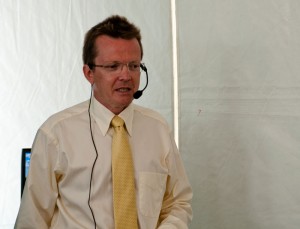Fit-for-purpose rigs, unconventionals drive Statoil production goals
By Joanne Liou, editorial coordinator
Statoil is directing its fit-for-purpose rig fleet and technology strategy to help reach a production goal of more than 2.5 million boe/day by 2020, up from 1.9 million boe/day in 2010. Noting recent successes in increasing the average oil recovery rate from Statoil-operated fields from 49% to 50%, the company wants to push that percentage even higher, Karl Johnny Hersvick, Statoil senior vice president of technology excellence, stated. The company outlined its growth strategy in a series of press conferences at the 2012 OTC last week in Houston.
Jon Arnt Jacobsen, chief procurement officer at Statoil, and Oystein Arvid Haland, senior vice president drilling and well, discussed their company’s shift from fixed platforms to using mobile rigs to drill subsea wells. In collaboration with Aker Solutions, Statoil’s Category B rig is under construction, with delivery of the first unit expected in the second half of 2015. The rig design fills the gap between light intervention vessels (Category A, which has been in operation since 2003) and conventional rigs (Category C), according to Statoil. The rig is designed to improve oil recovery, and its design has been optimized for heavy intervention and light drilling in existing wells.
A Category D rig, targeted for mid-water production operations, also is under construction and expected to be delivered in 2014 to 2015, while Category J is designed for shallow waters and harsh environments. The latter is expected to be delivered in 2015 and will provide 20% more cost-effective well construction.
Statoil’s developing rig fleet is compounded with the company’s focus on four areas: seismic imaging and interpretation, reservoir characterization and recovery, efficient well construction, and a “subsea factory.” The subsea factory project involves the development of the Åsgard subsea gas compression by 2015 and acquiring all the necessary elements for a subsea process facility on the seabed to accelerate production. “Our mission is that technology connected to (reservoir recovery) will contribute to increase an additional 1.5 mboe/d by 2020,” Siri Espedal Kindem, senior vice president of research and development, said. “Just as important is a step-change in well construction efficiency. We have a clear ambition ahead to reduce the time we spend on well construction by 30% and 15% in spending.”
Statoil currently has about 3,000 employees working on 300 increased-oil-recovery projects. In August, the research and development division will become the research, development and innovation division, Mr Hersvick stated. “It’s a concrete measure to get our hands on more good ideas, to push recovery rate even further. We cannot compete with supermajors of this world when it comes to funds and resources, but we can and we will compete when it comes to innovation.”

Moving onshore, Statoil expects 500,000 million boe/day to come from North American unconventionals by 2020, Torstein Hole, senior vice president of development production North America – US onshore, said. The company’s strategy for growth in US shale plays is founded in its presence in the Marcellus, Eagle Ford and Bakken, with the Eagle Ford paving the way for Statoil’s operatorship. Statoil entered a 50/50 joint development agreement with Talisman in 2010. With 165,000 net acres and 12 rigs currently drilling, the play has produced about 640 million boe to date. Statoil is positioned to become operator within that play by the end of 2013.




